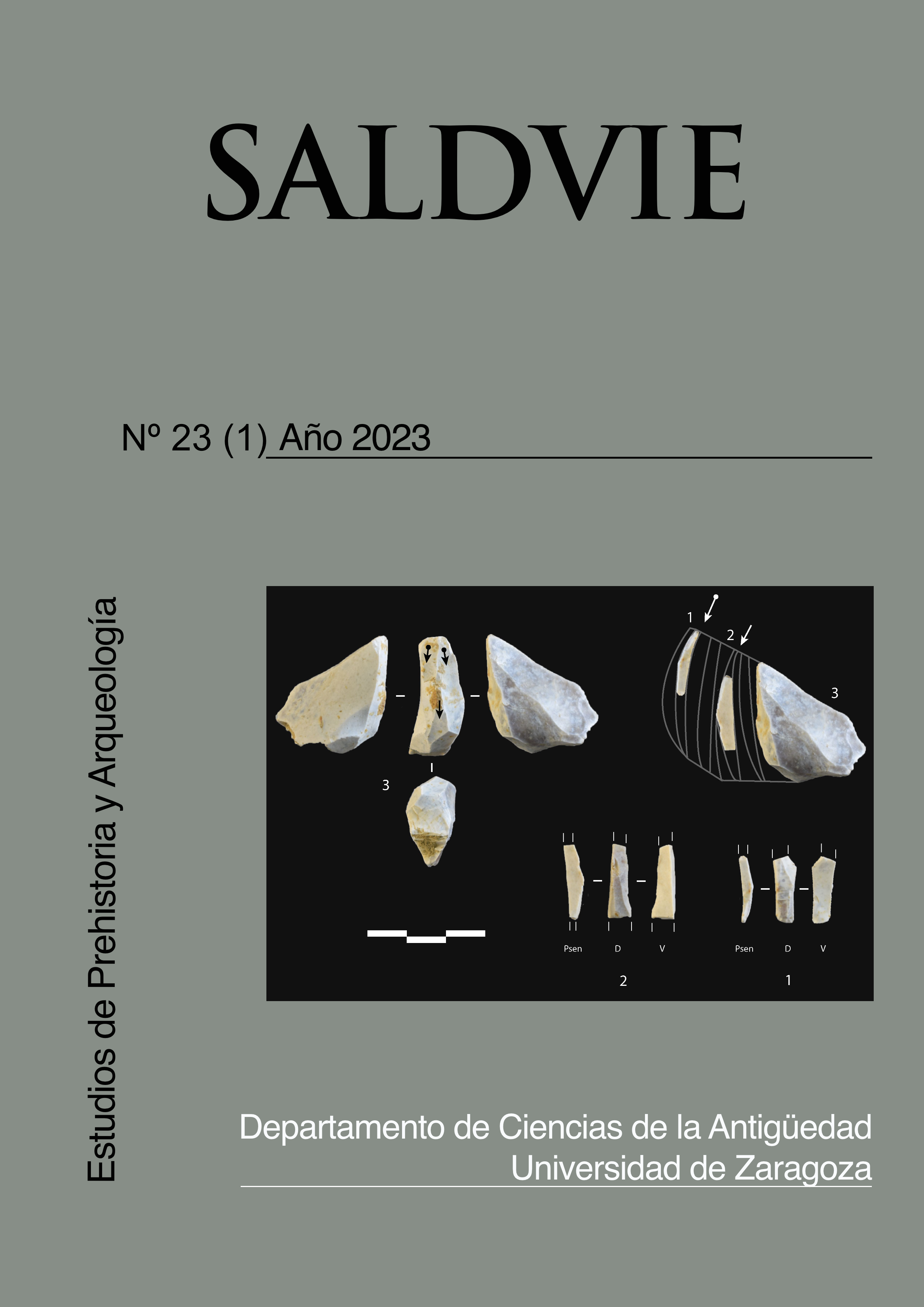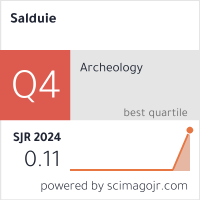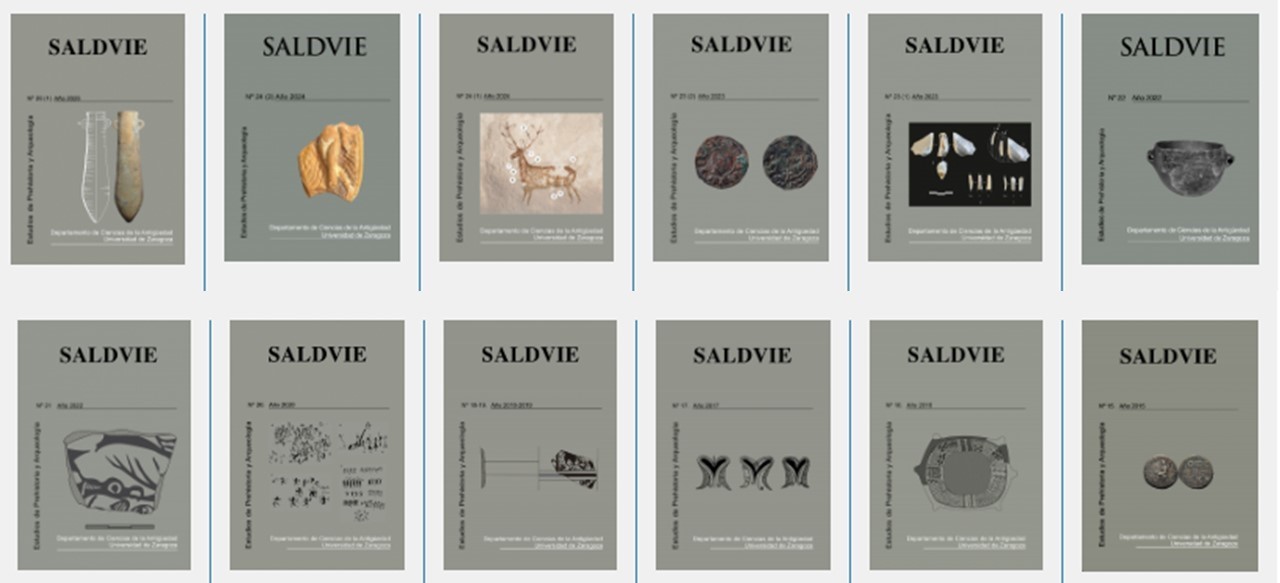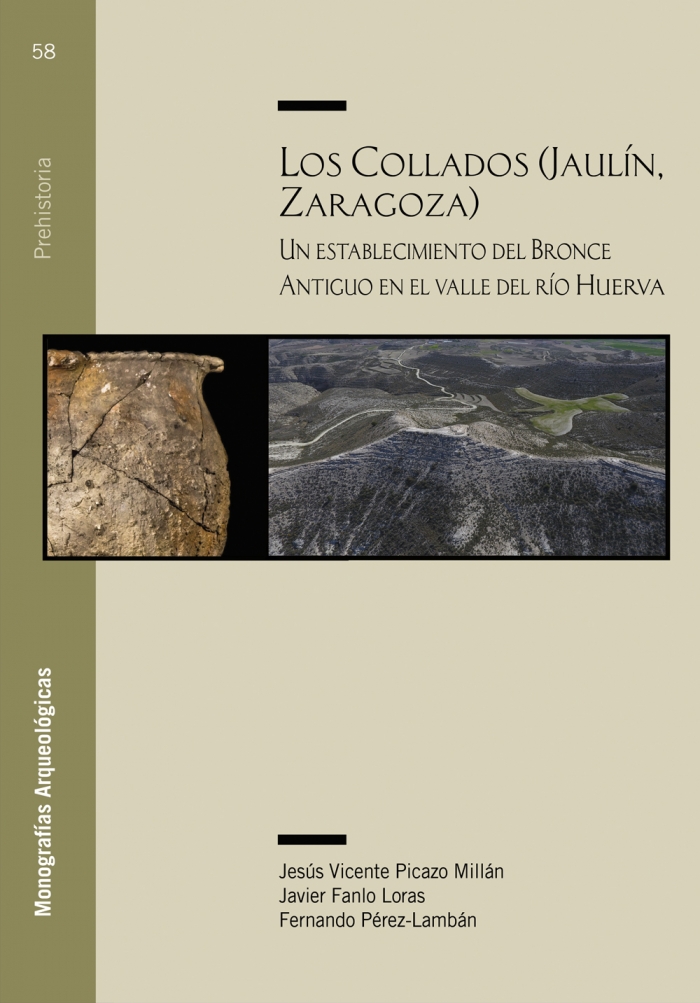Melka Kunture (alto Awash, Etiopía) entre 2.000.000 y 5.000 años
DOI:
https://doi.org/10.26754/ojs_salduie/sald.202318553Palabras clave:
Olduvayense, Achelense, Middle Stone Age, Late Stone Age, huellas de homininosResumen
Melka Kunture es un clúster de yacimientos prehistóricos situados en el altiplano etíope, a 2.000-2.200 m sobre el nivel del mar, en la cuenca alta del río Awash. El clima es más bien fresco (temperatura media anual de 17° C) y lluvioso. Los resultados palinológicos demuestran que la vegetación durante el Pleistoceno era de tipo afromontano y, por lo tanto, diferente a la de sabana que se desarrolla en cotas más bajas. Tras casi 60 años de excavaciones en 20 yacimientos y en unos 60 niveles arqueológicos distintos, la secuencia arqueológica identificada incluye el Olduvayense, Achelense, Middle Stone Age y Late Stone Age. También se han descubierto fósiles de homininos en asociación directa con industrias líticas de diferentes tecnocomplejos. Además, se conocen niveles icnológicos, que proporcionan información sobre la vida y el comportamiento de homininos y fauna. La investigación sobre la adaptación de los homininos al clima y al entorno de las tierras altas es relevante para entender cómo y cuándo se produjo el primer poblamiento de Europa.
Descargas
Referencias
Altamura, F., Melis, R.T. y Mussi, M. (2017). A Middle Pleistocene hippo tracksite at Gombore II-2 (Melka Kunture, Upper Awash, Ethiopia). Palaeogeography, Palaeocli-matology, Palaeoecology, 470: 122-131. https://doi.10.1016/j.palaeo.2017.01.022
Altamura, F., Bennett, M.R., D’Août, K., Gaudzinski-Windheuser, S., Melis, R.T., Reynolds, S.C. y Mussi, M. (2018). Archaeology and ichnology at Gombore II-2, Melka Kunture, Ethiopia: everyday life of a mixed-age hominin group 700,000 years ago. Scientific Reports, 8: 2815. https://doi.10.1038/s41598-018-21158-7
Altamura, F., Bennett, M.R., Marchetti, L., Melis, R.T., Reynolds, S.C. y Mussi, M. (2020). Ichnological and archaeological evidence from Gombore II OAM, Melka Kunture, Ethiopia: an integrated approach to reconstruct local environments and biological presences between 1.2-0.85 Ma. Quaternary Science Reviews, 244: 106506. https://doi.org/10.1016/j.quascirev.2020.106506
Bailloud, G. (1965). Les gisements paléolithiques de Melka-Kontouré, Cahier n°1. Institut Ethiopien d’Archéologie. Addis Abeba.
Bekele, D., Alamirew, T., Kebede, A., Zeleke, G. y Melese, A.M. (2017). Analysis of rainfall trend and variability for agricultural water management in Awash River Basin, Ethiopia. Journal of Water and Climate Change, 8: 127-141.
Bonnefille, R. (1972). Association polliniques actuelles et quaternaires en Ethiopie (vallées de l'Awash et de l'Omo). Thèse de Doctorat ès-sciences. Paris.
Bonnefille, R., Melis, R.T. y Mussi, M. (2018). Variability in the mountain environment at Melka Kunture archaeological site, Ethiopia, during the Early Pleistocene (~ 1.7 Ma) and the Mid-Pleistocene transition (0.9-0.6 Ma). En R. Gallotti y M. Mussi (coords.): The Emergence of the Acheulean in East Africa and Beyond. Contributions in honor of Jean Chavaillon (93-114). Vertebrate Paleobiology and Paleoanthropology, Springer. Cham.
Chavaillon, J. (1972). Melka-Kunturé, campagnes de fouilles 1969-1970. Annales d’Ethiopie, 9: 3 11.
Chavaillon, J. y Piperno, M. (coords.) (2004). Studies on the Early Paleolithic site of Melka Kunture, Ethiopia. Origines. Istituto Italiano di Preistoria e Protostoria. Firenze.
Di Vincenzo, F., Rodriguez, L., Carretero, J.M., Collina, C., Geraads, D., Piperno, M. y Manzi, G. (2015). The massive fossil humerus from the Oldowan horizon of Gombore I, Melka Kunture (Ethiopia, 1.39 Ma). Quater-nary Science Reviews, 122: 207-221. https://doi.org/10.1016/j.quascirev.2015.05.014
Friis, I., Demissew, S. y Van Breugel, P. (2010). Atlas of the potential Vegetation of Ethiopia. Biologiske Skrifter 58, Det Kongelige Danske Videnskabernes Selskab. Copenhagen.
Gallotti, R., Collina, C., Raynal, J.-P., Kieffer, G., Geraads, D. y Piperno, M. (2010). The Early Middle Pleistocene Site of Gombore II (Melka Kunture, Upper Awash, Ethiopia) and the Issue of Acheulean Bifacial Shaping Strategies. African Archaeological Review, 27: 291-322. https://doi.org/10.1007/s10437-010-9083-z
Gallotti, R. y Mussi, M. (2015). The Unknown Oldowan: ~1.7-Million-Year-Old Standardized Obsidian Small Tools from Garba IV, Melka Kunture,Ethiopia.PLoS ONE 10(12): e0145101. https://doi.10.1371/journal.pone.0145101
Geraads, D., Eisenmann, V. y Petter, G. (2004). The large mammal fauna of the Oldowan sites of Melka Kunture. En J. Chavaillon y M. Piperno (coords.): Studies on the Early Paleolithic site of Melka Kunture, Ethiopia (169-192). Origines, Istituto Italiano di Preistoria e Protostoria. Firenze.
Kieffer, G., Raynal, J.-P. y Bardin, G. (2002). Cadre structural et volcanologique des sites du Paléolithique ancien de Melka Kunture (Awash, Ethiopie): premiers résultats. En J.-P. Raynal, C. Albore-Livadie y M. Piperno (coords.): Hommes et Volcans. De l’éruption à l’objet, XIV Congrès UISPP, Symposium 15.2 (Liege, 2-8 Sep-tember 2002) (77-92). Les dossiers de l'Archéologis n°2, CDERAD.
Le Cabec, A., Colard, T., Charabidze, D., Chaussain, C., Di Carlo, G., Gaudzinski-Windheuser, S., Hublin, J-J., Me-lis, R.T., Pioli, L., Ramirez-Rozzi, F. y Mussi, M. (2021). Insights into the palaeobiology of an early Homo infant: multidisciplinary investigation of the GAR IVE hemimandible, Melka Kunture, Ethiopia. Scientific Reports, 11: 23087.https://doi.org/10.1038/s41598-021-02462-1
Melat, E. (2020). Hydro-Climatic Variability and Trend Analysis of Modjo River Watershed, Awash River Basin of Ethiopia. Hydrology: Current Research, 11: 329.
Mendez-Quintas, E., Panera, J., Altamura, F., Di Bianco, L., Melis, R.T., Piarulli, F., Ruta, G. y Mussi, M. (2019). Gombore II (Melka Kunture,Ethiopia): a new approach to formation processes and spatial patterns of Early Pleistocene Acheulean site. Journal of Archaeological Science, 108: 104975. https://doi.org/10.1016/j.jas.2019.104975
Morgan, L.E., Renne, P.R., Kieffer, G., Piperno, M., Gallotti, R. y Raynal, J.-P. (2012). A chronological framework for a long and persistent archaeological record: Melka Kunture, Ethiopia. Journal of Human Evolution, 62: 104-115. https://doi.org/10.1016/j.jhevol.2011.10.007
Mussi, M., Altamura, F., Macchiarelli, R., Melis, R.T. y Spinapolice, E. (2014). Garba III (Melka Kunture, Ethiopia): a MSA site with archaic Homo sapiens remains revisited. Quaternary International, 343: 28-39. http://dx.doi.org/10.1016/j.quaint.2013.08.028
Mussi, M., Altamura, F., Bonnefille, R., De Rita, D. y Melis, R.T. (2016). The environment of the Ethiopian highlands at the Mid Pleistocene Transition: fauna, flora and hominins in the 850-700ka sequence of Gombore II (Melka Kunture). Quaternary Science Reviews, 149: 259-268. https://doi.org/10.1016/j.quascirev.2016.07.033
Mussi, M., Méndez-Quintas, E., Barboni, D., Bocherens, H., Bonnefile, R., Briatico, G., Gerards, D., Melis, R.T., Panera, J., Pioli, L., Serodio, A., Rubio-Jara, S. (2023). A surge in obsidian exploitation more than 1.2 million years ago at Simbiro III (Melka Kunture, Upper Awash, Ethiopia). Nature Ecology & Evolution. https://doi.org/10.1038/s41559-022-01970-1
Mussi, M., Méndez-Quintas, E., Panera, J., Altamura, F., Di Bianco, L., Bonnefille, R., Briatico, G., Brunelli, E., Geraads, D., Mutri, G., Piarulli, F., Rubio Jara, S., Ruta, G., Sánchez-Dehesa Galán, S., Serodio Domínguez, A. y Melis, R.T. (2022). Une vue d’ensemble sur Melka Kunture, grand complexe de sites pléistocènes dans la vallée supérieure de l’Awash (Ethiopie). L’Anthropologie, 126: 102999. https://doi.org/10.1016/j.anthro.2022.102999
Mussi, M., Altamura, F., Di Bianco, L., Bonnefille, R., Gaud-zinski-Windheuser, S., Geraads, D., Melis, R.T., Panera, J., Piarulli, F., Pioli, L., Ruta, G., Sánchez-Dehesa Galán, S. y Méndez-Quintas, E. (2022). After the emergence of the Acheulean at Melka Kunture (Upper Awash, Ethiopia): from Gombore IB (1.6 Ma) to Gom-bore Iγ (1.4 Ma), Gombore Iδ (1.3 Ma) and Gombore II OAM Test Pit C (1.2 Ma). Quaternary International. https://doi.org/10.1016/j.quaint.2021.02.031
Mutri, G., Ruta, G., Briatico, G., Bamford M. y Mussi, M. submitted (e.p.). Living on the Awash. Everyday life and activities of a Later Stone Age community. Journal of African Archaeology.
Perini, S., Muttoni, G., Monesi, E., Melis, R.T. y Mussi, M. (2021). Magnetochronology and age models of deposi-tion of the Melka Kunture stratigraphic sequence (Upper Awash, Ethiopia) and age assessments of the main archeological levels therein contained. Quaternary Sciences Review, 274: 107259. https://doi.org/10.1016/j.quascirev.2021.107259
Profico, A., Di Vincenzo, F., Gagliardi, L., Piperno, M. y Manzi, G. (2016). Filling the gap. Human cranial remains from Gombore II (Melka Kunture, Ethiopia; ca. 850 ka) and the origin of Homo heidelbergensis. Journal of Anthropological Sciences, 94: 1-24.
https://doi.org/10.4436/jass.94019
Sánchez-Dehesa Galán, S., Méndez-Quintas, E., Bahain, J.-J., di Bianco, L., Bonnefille, R., Brunelli, E., Geraads, D., Melis, R.T., Serodio Domínguez, A., Voinchet, P. y Mussi, M. (2022). Age and formation processes of an Acheulean site with extensive accumulation of large cutting tools: Garba I (Melka Kunture, Upper Awash, Ethiopia). Archaeological and Anthropological Sciences, 14: 55. https://doi.org/10.1007/s12520-022-01521-6
Tadese, M.T., Kumar, L., Koech, R. y Zemadim, B. 2019: Hydro-climatic variability: a characterisation and trend study of the Awash River Basin. Ethiopia Hydrology, 6: 35. https://doi.org/10.3390/hydrology6020035
Descargas
Publicado
Número
Sección
Licencia
Derechos de autor 2023 Salduie

Esta obra está bajo una licencia internacional Creative Commons Atribución-NoComercial-SinDerivadas 4.0.
SALDUIE conserva los derechos patrimoniales (copyright) de los artículos publicadas, autorizando a usar, difundir, transmitir y exponer públicamente su contenido, siempre que se cite la autoría, la url y la revista, y no se use para fines comerciales. También se reserva el derecho de la reproducción de los artículos en copia impresa, formato de documento portátil (.pdf) o ediciones HTML de JoS. Los autores están de acuerdo con la licencia de uso utilizada por la revista, al igual que con las condiciones de autoarchivo y su política de acceso abierto.
















